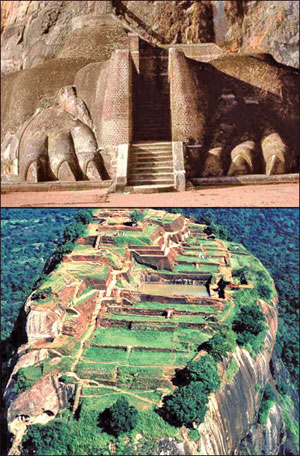The archaeological wonder of Sri Lanka
 The Archaeological Wonder of Sri Lankan city planning, arts,
gardenscaping, engineering, hydraulic technology and defence of the 5th
century AD is the the Sigiriya rock fortress. The Archaeological Wonder of Sri Lankan city planning, arts,
gardenscaping, engineering, hydraulic technology and defence of the 5th
century AD is the the Sigiriya rock fortress.
Before Sigiriya became a kingdom, the Sigiriya Rock base and places
such as Pidurangala which were endowed with many caves and a temple had
been the dwellings of Bhikkhus from around 3rd century BC. It is also
found that the areas had been inhabited by people prior to King
Kassapa's reign. Many caves also have Brahmi inscriptions dating back
from the 3rd century BC to 1st century AD.
After King Mahanama who ruled Anuradhapura from 410- 432 AD, a prince
named Dhatusena became the King of Anuradhapura in 459 AD, defeating the
Indian invader 'Pandu'.

He had two sons from two queens. Mugalan (also called as Moggallana)
from the head queen and Kassapa (also called as Kashyapa) from a
companion queen.
Prince Kashyapa, with the help of the general of the army of King
Dhatusena, named Migara, got his father killed and became the King.
Prince Mugalan, fearing for his life, escaped to India.
After 18 years, Prince Mugalan came with an army from India to fight
with King Kassapa. During the battle Kassapa killed himself thus Mugalan
became the King. He went back to Anuradhapura and ruled the country from
there and handed over Sigiriya back to the Bhikkhus.
The rock itself has its unique identity on its shape not found
anywhere else in the island and can be recognised miles away from a
distance.
Sigiriya was rediscovered during the British rule, by Major H. Forbes
in 1831. Climbing the Sigiriya summit was achieved by A.H.Adams and
J.Bailey in 1853.
 Sigiriya being a fortress, had been well designed for its defences by
having ramparts and moats built around it. There are several approaches
to the inner city and the most prominent is the Western entrance. Sigiriya being a fortress, had been well designed for its defences by
having ramparts and moats built around it. There are several approaches
to the inner city and the most prominent is the Western entrance.
From the summit of the rock, the land areas up to distances of tens
of miles can be watched making it hard for the enemy to make a surprise
attack on the kingdom.
King Kassapa had reverted his fortress to an ecological wonder by
having royal pleasure gardens, water gardens, fountain gardens and
boulder gardens made in the inner city as well as at the palace premises
on the rock summit. The most renowned is the Sigiriya rock paintings or
frescoes of Sigiri damsels locally called ' Sigiri Apsaras' painted on a
western rock face cavity about 100 metres high from the rock base.
There now remains around 21 paintings of Sigiriya damsels but there
had been around five-hundred paintings during King Kassapa's time along
several other places of the same Western rock face.
- Internet |

